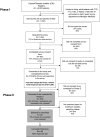Protocol for the diabetes, distress and disparities (3D) study: an explanatory sequential mixed-methods design
- PMID: 40216429
- PMCID: PMC11987096
- DOI: 10.1136/bmjopen-2024-088082
Protocol for the diabetes, distress and disparities (3D) study: an explanatory sequential mixed-methods design
Abstract
Introduction: Psychosocial factors impact diabetes outcomes, yet healthcare systems remain inadequately equipped to address these needs. Research centring on the experiences of people with diabetes (PWD) can inform programme implementation, policies and partnerships to address psychosocial care needs. The goals of the diabetes, distress and disparities (3D) study are to quantify the psychosocial care needs of PWD in a large academic medical centre, generate insights regarding how psychosocial factors shape diabetes outcomes and identify modifiable determinants of psychosocial care.
Methods and analysis: The 3D study is recruiting adults with type 1 (T1D), type 2 (T2D), latent autoimmune diabetes in adults (LADA) and gestational diabetes (GD) from the Caswell Diabetes Registry at Michigan Medicine. The 3D study uses an explanatory sequential mixed-methods design with two phases. Phase I (P1: target n=500, began July 2023) consists of an online survey to quantify prevalence and examine correlates of a wide range of psychosocial factors (eg, diabetes-related distress, depression, stigma). This survey was refined through consultation with PWD. Phase II (P2) involves semi-structured telephone interviews with n=40 P1 respondents, recruited using maximum variation sampling informed by demographic characteristics and responses to psychosocial survey measures. P2 will explore a subset of factors (eg, patient-provider communication, social support, barriers/promoters to care). To date, n=573 (5% response rate) have completed P1. In March 2024, we identified a target sample of P1 respondents (n=65) for recruitment into P2. All data collection was completed by September 2024. Analysis will involve quantitative linear and logistic regression to understand correlates of psychosocial outcomes from P1, and qualitative content analysis to clarify potential points of intervention from P2.
Ethics and dissemination: This study is approved by the University of Michigan Institutional Review Board (HUM00223735). Protocol materials are available at https://osf.io/yfz6b/. Findings from this study will be disseminated through peer-reviewed publications, presentations at conferences and outreach to key stakeholders, including creating educational materials for patient advocacy groups and interprofessional practice.
Keywords: cross-sectional studies; epidemiology; general diabetes; mental health; public health.
© Author(s) (or their employer(s)) 2025. Re-use permitted under CC BY-NC. No commercial re-use. See rights and permissions. Published by BMJ Group.
Conflict of interest statement
Competing interests: None declared.
Figures


References
MeSH terms
Grants and funding
LinkOut - more resources
Full Text Sources
Medical
